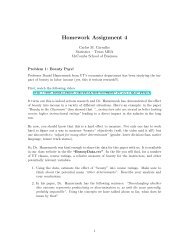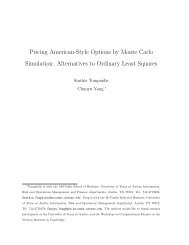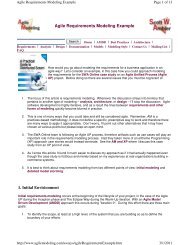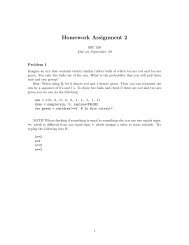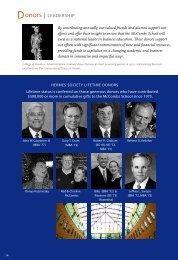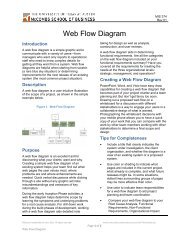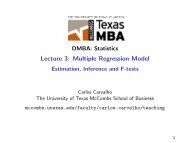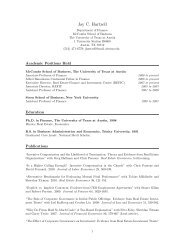Homework Assignment 2 - McCombs School of Business
Homework Assignment 2 - McCombs School of Business
Homework Assignment 2 - McCombs School of Business
You also want an ePaper? Increase the reach of your titles
YUMPU automatically turns print PDFs into web optimized ePapers that Google loves.
that Gerard will receive. For this reason, Gerard will use put options on the federal<br />
Class III milk price to hedge his revenue.<br />
6. Gerard wants the probability to be at least 95% that his revenue will be $12/cwt or<br />
more no matter what the California mailbox price is.<br />
Parts (a) and (b) below provide an example <strong>of</strong> how to determine the value <strong>of</strong> a put option on<br />
Class III milk on its expiration date. The same idea is used in a slightly more complicated<br />
context in parts (c) – (j).<br />
The discussion <strong>of</strong> put options on pages 6-8 <strong>of</strong> the case, and in particular the example at the<br />
bottom <strong>of</strong> page 7 and top <strong>of</strong> page 8 will be helpful in answering parts (a) and (b).<br />
(a) Suppose Gerard buys a December 15 put option on Class III milk in June with a<br />
strike price <strong>of</strong> $12/cwt. If the Class III milk price on December 15 is $11.50/cwt, how<br />
much is the put option worth when it expires on this day?<br />
(b) Suppose the price for the put option in part (a) is $0.30/cwt and that the trading<br />
costs for purchasing the option are $0.05/cwt. Combining the value <strong>of</strong> the option<br />
obtained in part (a) with the cost information, what is Gerards net gain on the option<br />
(i.e. what is the value <strong>of</strong> the put option minus the option cost and trading cost)?<br />
For parts (c)–(j), suppose Gerard in June decides to hedge his December 15 revenue by<br />
purchasing a put option on Class III milk with a strike price <strong>of</strong> $14.25/cwt and an expiration<br />
date <strong>of</strong> December 15.<br />
You should do the calculations for parts (c)–(h) assuming the costs <strong>of</strong> the option are zero.<br />
A way to incorporate the additional costs into the hedging process is discussed in parts (i)<br />
and (j).<br />
(c) Plot the Class III milk price against the California mailbox price and add the estimated<br />
regression line to the plot. To add the estimated regression line right click on any data<br />
point, click on Add Trendline, click on the box above Linear, click on the Options tab,<br />
check the box next to Display equation on chart and click OK. What is the equation<br />
<strong>of</strong> the estimated regression line? How much do you expect the Class III milk price to<br />
change on average for a $1/cwt change in the California mailbox price?<br />
For the remainder <strong>of</strong> the problem use 0.60 as the value <strong>of</strong> σ (the standard deviation <strong>of</strong> the<br />
error term) and the estimated regression line as if it were the true regression line to answer<br />
the following questions.<br />
(d) What is the probability that Gerards December 15 put option on Class III milk with<br />
a strike price <strong>of</strong> $14.25 is in the money (i.e. worth something) on December 15 if the<br />
California mailbox price on December 15 is $12.50/cwt?<br />
(e) Suppose the California mailbox price on December 15 is $12.00/cwt. What is the<br />
probability that the value <strong>of</strong> the put option will be greater than $0.50?<br />
8



